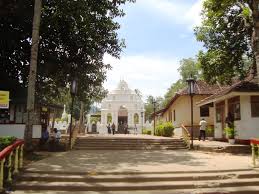Directory
MUTHIYANGANA RAJA MAHA VIHARAYA
Muthiyangana Raja Maha Viharaya lies in the midst of the city of Badulla in the Uva province. The History of this temple goes back to the time of Buddha but this area around Badulla (especially Uva Province) goes way back in to the time of 19th - 18th century BCE. It is believed that a mighty king called Rawana was ruling this country with Badulla as the capital. It is also believed that the War of Rama and Rawana in Ramayana also happened in this area.
There are many places and names which identify this area, such as Seetha Eliya, Seetha Kotuwa, and Rawana Ella as described in Ramayana. It is said that the Rawana finally lost the war and his defector brother Vibishana took the capital to Kelaniya and the Uva gradually got lost in history until the 5th century lost in history.
On the eighth year after attaining Buddha hood, the Buddha and 500 Arahants visited this Island for the third time on the invitation of Naga King Maniakkhitha to Kelaniya. On that visit, Buddha came to Badulla on the invitation of the Deva King Indaka (now elevated to the Deity status), ruler of the Namunukula Mountain Range.
King Indaka built a stupa enshrining some hair and Mukthaka Dathu (drops of sweat turned in to pearls) of Buddha on the location where Buddha made his sermons. This is the birth of the Muthiyangana Stupa. Since then this stupa and the temple has been expanded, reconstructed and renovated by many kings.
The entrance to the temple is the 'Thorana' of an unknown period. This is a unique design with six levels. First level include the main entrance and above it on the second level is a typical Makara (dragon) Head. On the sides of the head are two guard figures and at the corners are two lion figures.
On the third level there are two 'Vamana' figures and at the edge two animals probably lions. These figures are not as clear as the lion figures on the second level. On the centre of the third level is a high stand which goes right up to the fourth level on it are two bulls and the special features of these bulls are that they are decorated and have large humps. Such bulls are a feature of Hinduism and this feature indicates some influence of Hinduism in the making of this structure. Lastly and on top of the fifth level is a seated Buddha statue. The fifth is dedicated to the Buddha statue. On the sixth level are two peacocks which complete the outline of the structure.
As you enter the temple is the main Image house. At The entrance is a colourful 'Makara Thorana'. Right above the entrance and below the dragon head is a figure of Maître Bodhisattva.
On the right hand side of the Image house is a statue of Deity Indaka, the protector of the Muthiyangana Holy Ground and the Namunukula Mountain Range. On the right is the statue of Maitreya Bodhisattva.
Passing the Image house you come to the holiest structure of the temple, the stupa which enshrines the hair and the Mukthaka Dathu of Buddha. The initial stupa built by the Deit











